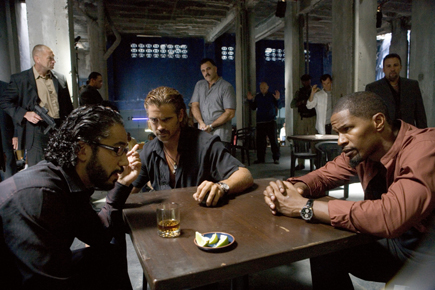 Discard
Discard
your biases. If you were on the fence, allow whatever preconceived
notions to deteriorate into nothingness. And even though the Miami Vice pilot episode, with its coolly detached slivers of stylization (I don’t think Collins’ In the Air Tonight
has been used quite as succinctly since) is something of a revelation,
don’t let it overshadow the plain fact that Mann has known what he was
doing and he does it incredibly well for the more bulging theatrical
incarnation.
Mann throws out the bathwater with the baby
inside. He just keeps the wee one’s name. Any treacherous nostalgia one
harbored for the past two decades is all but moot; it doesn’t exist
here. With a completely rejigged idea, Mann’s stylistic choices serve
by creating a lived-in environment for these new events to unfold. F.X.
Feeney remarked that Mann is a “solid maker of worlds” and I can get
behind that. As it was in almost every film Mann has shepherded, Miami Vice
continues his creative drive to mold indelible imagery with inviting
developments. In the case of the latter, Vice is certainly full of
them. It’s an engaging, cohesive environment that’s on screen.
You
get plunked right into the film. There are no opening credits, nary a
title card, or even a hint of the Universal theme. The movie starts off
silent and – bang – you’re in the middle of a studious stakeout
somewhere in the raging party nights where Will Smith crooned
bienvenidos. It’s almost as if Mann takes a deep breath and exhales the
possibilities of his film, leaving you somewhat in the dust. But you
will catch up. Who these characters are and what situation they’re
placed in arrives quickly. I don’t think anyone is going into this
movie not knowing from cultural regression that Farrell is playing the
role of Crockett and Foxx of Tubbs. Absolutely nothing is confusing
once you’re able to strategically place their symbiotic relationship.
What
I’ve always enjoyed about Mann’s film is the insistence that everyone
brings “it” to the table, even supporting characters. Collateral had that tiny turn by Javier Bardem that was alluring. Ali had the stupendous Jeffrey Wright. The Insider had the wondrous Bruce McGill has the hard-assed trial lawyer. In Vice,
there’s the effervescent Barry Shabaka Henley and Ciarán Hinds as the
instigators of sorts. They’re the point men (Henley as the boy’s main
boss and Hinds as the FBI heavy). While Hinds isn’t in the film enough
(one of my gripes. The main reason behind his story with Crockett and
Tubbs isn’t fully hashed out. He shows up and gives out orders,
questions them. It never arcs in a way that is satisfying), Henley
renders his role with a gravitas that speaks with a seemingly earned
authority, but he also suffers from Hinds’ circumstance.

Once Gong Li gets into the tangled web, Vice
arrives at a fairly taut place. Aside from struggling with her
dialogue, her tough-as-nails businesswoman brings a shadowy presence
with Arcángel de Jesús Montoya (the formidably cast Luis Tosar), the
pair diving into the rickety setups. She exhibits a natural grace and a
fragility almost missing from the testosterone escapades (although I’d
be remiss to discuss Naomie Harris’ small contribution as Foxx’s
significant other. She’s convincing, but not in the movie enough for
one to cultivate familiarity with). As Jose Yero, John Ortiz’s polished
Montoya wingman conjures up the more balanced amount of impregnable
sturdiness that a miscreant like himself would surely revel in.
The
leads play nice together. Farrell, with his inviting Fu Manchu pornstar
moustache, is convincing as Crockett. Thankfully, there’s not a touch
of Don Johnson in his performance – and there needn’t be. If there was
it would be too clichéd, as it has infiltrated our society beyond its
mere entertaining aspects (informing fashion, speech, and vehicular
love). As one of the driving forces of Vice’s emotional entanglements,
Farrell is masculine enough to equate what Mann’s attempting on screen,
but slightly rounded down in a manner that regresses to a more complete
transformation. Foxx, on the other hand, allows his goateed facial hair
to ease into a more realized portrayal of Tubbs. He gets to spout some
great Mann-ian dialogue, lines like “there’s undercover and then
there’s which way is up.” Clearly, he’s a man of action, a cool cat
whose way he holds himself allows for the believability of Foxx as an
undercover cop during his downtime.

As such, one of the priorities that Mann explores rigorously is that of the nature of
undercover work. Just when is the line between truth and fiction drawn?
How do these men put on one face for their significant others and
another when dealing with some truly bad dudes? Mann doesn’t humanize
their efforts any more than the next guy, but he tussles with the
complexities that arise with it. Unfortunately, this situation provides
the most pull between a cohesive characterization and what’s presented
on screen. Crockett feels the most caught up between the duo, but his
story with Gong’s Isabella appears semi-asymmetric. Their unfortunate
circumstance feels a touch too topical at times; whisperings, secret
caresses on the dance floor, forbidden glances on the pier. It’s tough
to equate, because it feels real, but hasn’t quite ripened.
One
of Mann’s recurring themes is paraded on display: that of masculine
professionalism. The idea of what men have to offer to one another in
times of crisis, whether it be the level-head to sniff out danger, or
the Jiminy Cricket conscientious voice that wonders if righteous ideas
are coalescing. You’ll see it throughout most of his films (Heat
more-so than the rest). Miami Vice
sort of takes that theme and twists it ever-so slightly, attempting to
bring absolute credence to the sort of ideas that Mann’s been building
up to for a long time, maybe from his short days in London. As a whole,
it helps buoy the cinematic environment on display.

It’s been wildly speculated that most of Collateral was
shot on High-Definition Digital Video (any given day it ranges from
40-80%), mostly because Mann wanted to squeeze out the tremendous
nighttime shots that just can’t be accomplished shooting with the
sensitivities of 35mm. That same state of visual play runs right
through Vice. Collaborating again with Cinematographer Dion Beebe (Memoirs of a Geisha),
Mann manages to bathe the film in a signature sheen with his grays,
deep blacks, and cool blues. There are moments when the film is
bombarded with digital flecks (especially in the scene where Crockett
and Tubs are pressuring Nicholas to get them into Montoya’s sanctum),
but they’re non-intrusive. Filming Vice
in digital allows it to have the immediate feel of realism. And that
certainly reinforces the more thematic elements, which then beef up the
documentary-like feel of Crockett and Tubb’s descent.
Further
implementing that sense is the element of violence upon the characters.
There are moments, such as when an opening deal goes wrong, and when
people play fast and loose with some triggers, where Mann spits out
what’s happening on screen in rapid-secession. Body parts are blown
apart – if you’ve ever wanted to see what ridiculously large bullets
will to do an upper torso, this movie is for you – and nothing is ever
dwelled upon. There are no slo-motion lingering shots. The violence
occurs and then we move on. Bullets are fired and they hit, ricocheting
off of appendages. Then we continue onward. The violence is violence is
violence, and Mann never takes a voyeuristic role in portraying it. The
fact that Mann doesn’t slather it with style makes it completely his
own – like the rat-a-tat-tat of a Tommy Gun from a man who clearly
knows his Tommy Guns.

What matters is that Miami Vice
as a whole is captivating, riveting, and thoroughly engaging. It’s just
the sort of movie going experience that demands your attention, unlike
the other wishy-washy films of yesterday. Many will throw around the
word ‘adult’ to describe it, but I dislike that word. Instead, it’s
nothing short of a progressive bound for a director of fully realized
environments, an engrossing experience that shows what good filmmaking
is capable of.
Smooth, indeed.